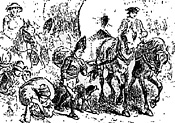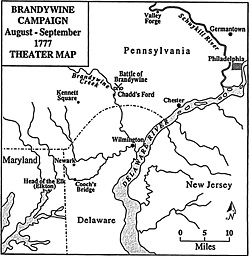 General William Howe, the British commander at New York in 1777, had been frustrated in his attempt to capture Philadelphia in 1776 when George Washington surprised the Hessians at Trenton at Christmas time. Washington's victory forced Howe to undertake another campaign in the hope of surpressing the rebellion in the American colonies. However, a movement into northern New Jersey in June 1777 failed to draw Washington into battle.
General William Howe, the British commander at New York in 1777, had been frustrated in his attempt to capture Philadelphia in 1776 when George Washington surprised the Hessians at Trenton at Christmas time. Washington's victory forced Howe to undertake another campaign in the hope of surpressing the rebellion in the American colonies. However, a movement into northern New Jersey in June 1777 failed to draw Washington into battle.
Howe then transported his anny to the head of Chesapeake Bay for the purpose of marching on Philadelphia from the south. This strategy allowed Howe to capture that city, but, while the Americans were defeated at the Battle of Brandywine, Howe failed to destroy Washington's army.
In the following pages, the important Battle of Brandywine on September 11, 1777 is told as recorded in the diaries of Hessian soldiers who were engaged in the battle.
Howe Lands His Army at Head of Elk
The official journal of the Hesse-Cassel Jaeger Corps provides the following information concerning the situation of Howe's army, commencing August 28, 1777 after landing at Head of Elk in Maryland:
 "The army departed Turkey Point and marched to Elkton which had been deserted by all the inhabitants. We had no reports about the enemy, and no maps of the interior of this land, and no one in the army was familiar with this area.
"The army departed Turkey Point and marched to Elkton which had been deserted by all the inhabitants. We had no reports about the enemy, and no maps of the interior of this land, and no one in the army was familiar with this area.
Large Map Version (slow download: 92K)
After we had passed the city, no one knew which way we wae to go. Therefore, men were sent out in all directions until finally a Negro was found, and the army had to march according to his directions. This Negro knew nothing about the enemy army himself, but said that a corps of the same was reported to be in the area, and that some of their scouting parties were seen by the Jaeger Corps, which constituted the Advance Guard.
We remained lying here (in camp) until September 3rd and meantime took several prisoners from the frequently observed scouting parties."
"September 3: The Jaegers, consisting of the companies of Major Ernst Carl von Prueschenck, Captain Carl August von Wrede, Captain Johann Ewald, and the Ansbach Jaeger Company, in all about 400 men, were the advance guard for a column under General Cornwallis and learned during the march that enemy pickets had been there (Cecil Courthouse)...
After half an hour our flankers saw the enemy's rear. The mounted jaegers engaged them at once, and Captain Ewald, who led the corps' advance guard, soon came under fire. Then we saw the enemy, consisting of about 1,000 men, as they marched into a thin woods.
The Jaeger Corps deployed from the middle, to right and left, and formed so that the Ansbachers were in the middle, the point which the enemy at once attacked. They were driven back into another woods with considerable effort. Here they defended themselves obstinately, which brought our right wing, under Captain Wrede, with the hanger (saber) to the attack.
We also drove the enemy from this place, and they took a third position behind Cutgers Bridge. We buned between thirty and fony of the enemy dead, not counting those concealed in the bushes. Our loss was one dead and fifteen wounded Hessians, and four wounded Ansbachers."
An Ansbach Jaeger's Version
One of the officers of the Ansbach Jaeger Company which landed at the Head of Elk with Howe's army was Lieutenant Heinrich Carl Philipp von Feilitzsch, whose diary entries for the period, in part, are as follows:
-
"August 28: At three o'clock we marche. I had the advance guard and soon ran into rebels. After a few shots they retreated. We took a few prisoners. Not far from Elkton an officer of our corps took fourteen small ships on which there was sugar, coffee, tobacco, and other provisions and also a great amount of silver products from Philadelphia. The value was estimated at one million guilders. This day we marched about eight miles...
August 31: Here I must say that this region of Maryland does not appeal to me. Compared with other provinces where we have been, this region is not well-developed. A bare woods, here and a small place with a house and field, but where not a soul is to be seen...
September 1: It was exceptionally hot. During the night there was a false alarm when a jaeger deserted his post and ran back into camp claiming that the rebels were coming and were only three hundred yards from us. This was all untrue...
September 3: We marched out of our camp at four o'clock in the morning. At a distance of about two and one-half miles we entered Pennsylvania and shortly thereafter encountered an enemy corps of three thousand men in the region of Wellstreg, or the Fort Euren Kill or Katschers Mill.
The enemy stood firm. The fire was extremely heavy and lasted about two hours. Only our corps was engaged and a few English. The enemy attacked three times. We lost one dead and ten wounded while the rebels suffered nearly fifty dead and according to the deserters, very many wounded. We made few prisoners.
Our jaegers conducted themselves well and after the enemy was driven back, we entered camp duing the afternoon not far from this place. The affair began at eight o'clock and lasted until ten. The company had two wounded, a corporal and a jaeger.
September 8: We moved out at five o'clock in the morning. We marched about seven miles along a route not suspected by the enemy, although he had obstructed the obvious route with chopped down trees and entrenclunents...
September 10: I must note here in Pennsylvania, that the inhabitants are encountered everywhere. This province is more loyal to the King than all the others. Therefore, nothing is taken from the inhabitants. It is not more heavily populated than the others."
Ensign Rueffer's Diary
Ensign Carl Friedrich Rueffer, of the Hesse-Cassel von Mirbach Regiment, entered comments about the progress of the anny in his diary also:
-
"August 29: In this stretch of land we have not seen any females because they were told by the rebels that the Hessians would have misused them in an unpleasant manner, so they have all fled...
August 30: At noon today we received orders to march tomorrow and those among the sick needing special care were sent aboard the hospital ship...
August 31: At every house we passed a pardon letter was nailed, and a watch was posted to prevent looting...
September 3: Today for the first time, the Jaegers and Light Infantry were sharply engaged with the enemy. Our losses were about twenty men. The loss on the other side is still unknown...
September 5: According to the statement of a dragoon deserter, the enemy has withdrawn across the so called Christiana Bridge, which they reportedly had strongly occupied, and their corps, which was commanded by two generals, Armand and Holzendorf, of the French service, on the third lost three hundred men including those carried as missing...
September 8: At two o'clock we passed Newark, a very pleasantly built city of about sixty houses, but completely uninhabited. Also, now and again, very pleasing country homes which previous to this time we had seldom encountered in this area because it is rather thinly settled."
September 9: Prom this date we encountered many owners of houses, most of whom were Quakers and who appeared to be loyal to the crown. Toward ten o'clock this night our patrols encountered parties of the enemy. However, it was an adjutant from the commander-in-chief with an escort of dragoons banging an order of General Wilhelm von Knyphausen to change his march because information concerning a change in the enemy's dispositions had been received during the march. Unfortunately, the adjutant was fatally wounded."
Feilitzsch's Account of the Battle of Brandywine
- "We marched at four o'clock in the morning. At eleven o'clock we halted in a woods in order to first reconnoiter the enemy. An hour later we resumed our march until two o'clock when we again halted because no one knew where or how the enemy was located.
During this time we heard a heavy cannonade from near where we had been in the morning. This was General von Knyphausen who had gone a different way with the first cotumn and attacked the enemy's left wing. That was only a feint, however, to draw the enemy's attention to himself until both columns could attack at the same time.
At three-thirty our advance guard encountered the enemy. At once the army marched into battalion order. Our corps entered the line on the end of the left wing. At exactly four o'clock the battle began. The small anns fire was terrible, the counterfire from the enemy, especially against us, was most concentrated. All the battalions made the attack.
The enemy had made a good disposition with one height after the other to his rear. He stood fast and was certainly four times as strong as we were. However, all the English and Hessians conducted themselves with great strength and with the bayonet. The enemy was defeated and had to retreat.
The battle lasted until seven o'clock and during their flight Knyphausen sharply cannonaded them. Our company suffered four wounded and five dead, including one officer who will surely die later. The loss for the entire army amounts to about five hundred men.
The enemy loss cannot not be determined because, in so far as possible, they took thelr wounded with them. Still their losses are much greater than ours according to the statements of the many deserters. They also lost one field culverin. The battalions took post on Brandywine Hill not far from Brandywine Town, or Delanot. At eight o'clock in the evening we entered camp not far from that place. Once again, God had helped us."
More Battle of Brandywine Accounts (Part II)
Additional Notes on the Battle of Brandywine
Brandywine Order of Battle
Back to American Revolution Journal Vol. I No. 1 Table of Contents
Back to American Revolution Journal List of Issues
Back to Master Magazine List
© Copyright 1997 by James E. Purky
This article appears in MagWeb (Magazine Web) on the Internet World Wide Web.
Other military history articles and gaming articles are available at http://www.magweb.com